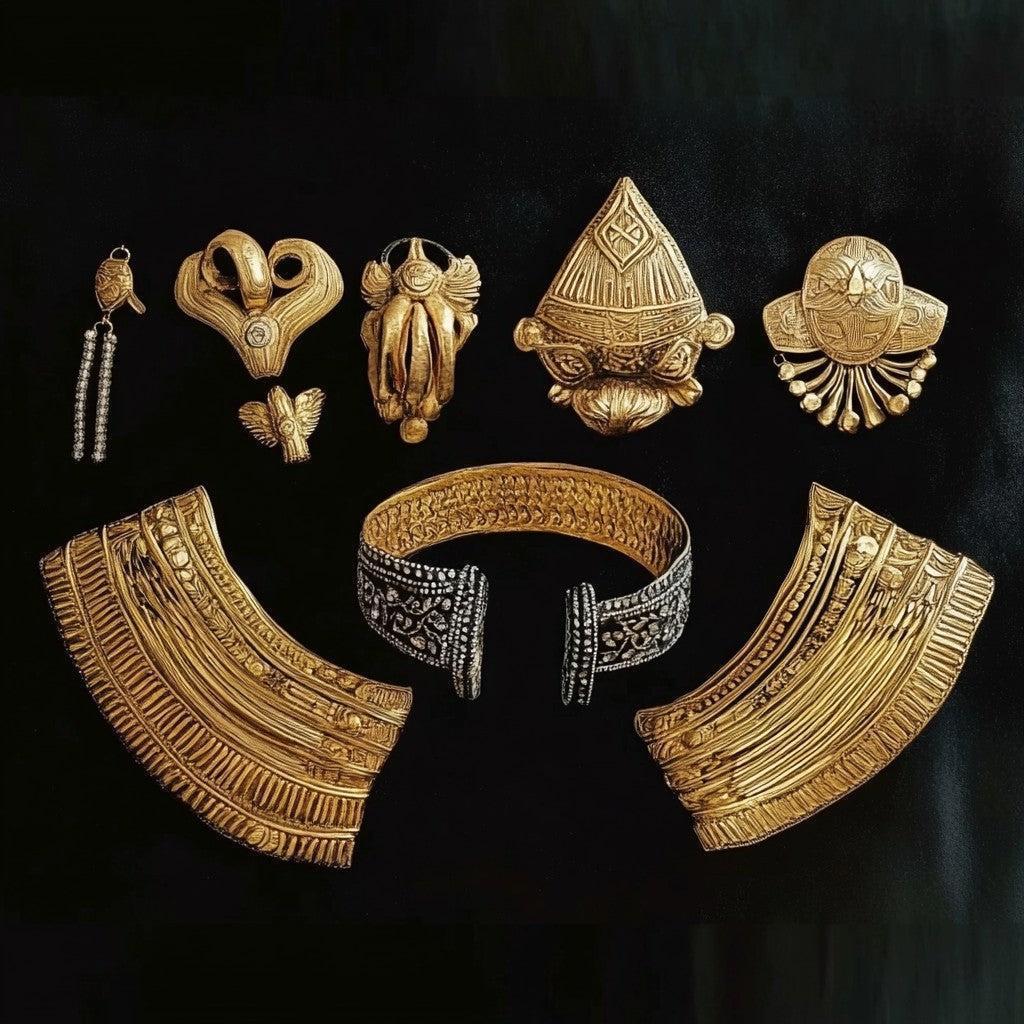
The Rich Legacy of Sumatran Jewelry: History, Influences, and Techniques
Share
Sumatra, a melting pot of cultures and traditions, boasts a remarkable jewelry-making heritage influenced by ancient kingdoms, maritime trade, and indigenous artistry. From the grandeur of the Sriwijaya Empire to the intricate craftsmanship of the Batak and Minangkabau peoples, Sumatran jewelry reflects a blend of Hindu-Buddhist, Islamic, and local motifs, each region offering a distinct style and technique.
Aceh Kingdom (1496–1903)
The Aceh Sultanate, established in 1496, became a powerful Islamic kingdom, influencing jewelry-making traditions with Persian and Mughal aesthetics. At its peak during the rule of Sultan Iskandar Muda (1607–1636), Aceh controlled major trade routes, facilitating the influx of Arabic calligraphy, floral motifs, and geometric patterns into its jewelry designs. Gold and silver ornaments were often set with rubies, sapphires, and pearls, sourced through extensive trade networks. Skilled artisans mastered engraving and filigree work, producing elaborate ceremonial pieces.

Aceh, gold and silver earplug.
Gayo-Alas (Central Aceh, Ancient-Present)
The Gayo and Alas people specialized in beaded jewelry and silverwork, often incorporating coral beads into their designs. Using casting and repoussé techniques, their creations were deeply connected to local traditions and ceremonies, a practice that continues today.

Gayo Alas, silver and gold alloy bracelets.
Batak Toba & Batak Karo (Ancient-Present)
The Batak people were exceptional metalworkers, particularly in brass and silver. Distinctive items included bronze rings and Toba amulets, which featured lizards, snakes, and totemic symbols believed to offer protection. Lost-wax casting enabled the creation of detailed ornamental patterns, while torque necklaces and ritual pendants played a significant role in cultural identity. The Batak Karo are among the most talented craftsmen in Sumatra.

Batak Toba bronze ring combines the attributes of a lion, a naga, and an elephant.

Batak Toba Bronze armband.

Batak Karo, gold alloy, flower crown-shaped men's ring.
Nias (Ancient-Present)
Nias jewelry, especially gold ornaments, symbolized social status. The Kalibubu necklace, a rigid gold or brass choker, was traditionally worn by warriors. Hammered gold leaf overlay and repoussé techniques were common, with motifs reflecting strength and protection.

Nias, gold Kalibubu torque.
Riau (14th Century-Present)
Jewelry in Riau reflected Malay and Acehnese influences, featuring filigree and repoussé techniques. Goldsmiths crafted delicate earrings, pendants, and bangles, often inlaid with pearls and gemstones to enhance their elegance.

Riau gold bracelet.
Minangkabau (13th Century-Present)
Minangkabau goldsmiths were renowned for intricate filigree headdresses (suntiang) and silver-plated brooches (pending). Techniques such as repoussé and engraving were used to create delicate, lace-like goldwork. Engraved silver belts and gilded hairpins were essential elements of bridal attire, symbolizing heritage and status.

Minangkabau, gold and rubies snake bracelet.
Mentawai (Ancient-Present)
Unlike other regions, the Mentawai people favored organic materials like shells, bones, and beads over metal. Jewelry was deeply tied to spiritual beliefs, with hand-carved pieces often representing connections to nature and ancestral spirits.

Mentawai shaman jewellery, coral and glass beads, natural fibres.
Sriwijaya Empire (7th–13th Century)
The Sriwijaya Kingdom, with its capital in modern Palembang, was a powerful maritime empire that played a crucial role in shaping Sumatran jewelry. Goldsmithing thrived due to abundant resources and trade with India, China, and the Middle East. Techniques like filigree, repoussé, and granulation were widely used, creating detailed gold ornaments adorned with lotus motifs, stupas, and celestial deities, mirroring Buddhist symbolism.

Palembang, gold gilded on silver lotus bracelets.
Lampung (Ancient-Present)
Lampung is famous for its gold jewelry and textiles adorned with gold thread (tapis). The Pending belt buckles were large, ornate pieces cast in gold, worn as status symbols. Cucuk Sanggul (gold hairpins), crafted using repoussé and filigree techniques, adorned women’s hairstyles, while gold-plated ornaments with floral and bird motifs played a role in ceremonies.

Lampung, gold crown.
Sumatra’s jewelry-making traditions are a testament to the region’s diverse influences, blending indigenous artistry with global trade influences. Techniques like filigree, repoussé, granulation, and lost-wax casting showcase the exceptional craftsmanship of Sumatran artisans. These regional styles remain an essential part of Sumatran identity, worn in rituals, passed down through generations, and celebrated as cultural treasures.
